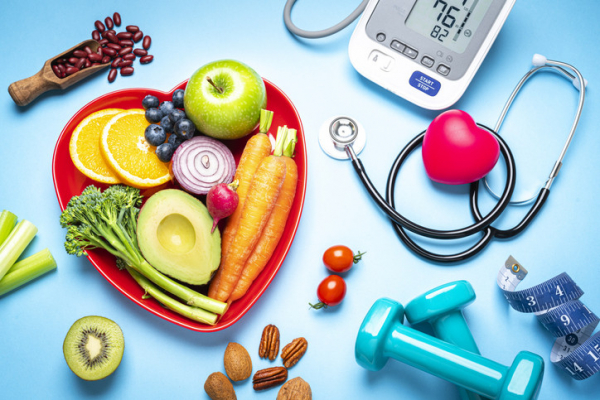

How well are you protecting yourself against heart disease, the nation’s leading cause of death? A check of five important numbers can give you a good idea.
“For my patients, I typically look at their blood pressure, blood sugar, LDL cholesterol and triglycerides values, and their waist circumference,” says Harvard Heart Letter editor-in-chief Dr. Deepak L. Bhatt, who directs interventional cardiovascular programs at Harvard-affiliated Brigham and Women’s Hospital. Those values provide a picture of a person’s overall health and, more specifically, what factors they may need to address to lower their chance of a heart attack or stroke, he says.
Below are the ideal values for each measurement, along with why they’re important and targeted advice for improving them. Universal suggestions for improving all five measurements appear at the very end.
How do your heart health numbers stack up?
While the ideal values are good goals for most people, your doctor may recommend different targets based on your age or other health conditions.
Blood pressure
Less than 120/80 mm Hg
Blood pressure readings tell you the force of blood pushing against your arteries when your heart contracts (systolic blood pressure, the first number) and relaxes (diastolic blood pressure, the second number). Your blood pressure reflects how hard your heart is working (when you’re resting or exercising, for example) and the condition of your blood vessels. Narrowed, inflexible arteries cause blood pressure to rise.
Why it matters to heart health: High blood pressure accelerates damage to blood vessels, encouraging a buildup of fatty plaque (atherosclerosis). This sets the stage for a heart attack. High blood pressure forces the heart’s main pumping chamber to enlarge, which can lead to heart failure. Finally, high blood pressure raises the risk of strokes due to a blocked or burst blood vessel in the brain.
What helps: A diet rich in potassium (found in many vegetables, fruits, and beans) and low in sodium (found in excess in many processed and restaurant foods); minimizing alcohol.
LDL cholesterol
Less than 100 mg/dL
A cholesterol test (or lipid profile) shows many numbers. Doctors are usually most concerned about low-density lipoprotein (LDL) cholesterol, particles that makes up about two-thirds of the cholesterol in the blood.
Why it matters to heart health: Excess LDL particles lodge inside artery walls. Once there, they are engulfed by white blood cells, forming fat-laden foam cells that make up atherosclerosis.
What helps: Limiting saturated fat (found in meat, dairy, and eggs) and replacing those lost calories with unsaturated fat (found in nuts, seeds, and vegetable oils).
Triglycerides
Less than 150 mg/dL
Perhaps less well-known than cholesterol, triglycerides are the most common form of fat in the bloodstream. Derived from food, these molecules provide energy for your body. But excess calories, alcohol, and sugar the body can’t use are turned into triglycerides and stored in fat cells.
Why it matters to heart health: Like high LDL cholesterol, elevated triglyceride values have been linked to a higher risk of heart attack and stroke.
What helps: Limiting foods that are high in unhealthy fats, sugar, or both; eating foods rich in omega-3 fatty acids (such as fish); avoiding alcohol.
Blood sugar
Less than 100 mg/dL
High blood sugar defines the diagnosis of diabetes. Type 2 diabetes is most common. It occurs when the body develops insulin resistance (insulin enables cells to take in sugar) and does not produce enough insulin to overcome the resistance.
Why it matters to heart health: High blood sugar levels damage blood vessel walls and cause sugar (glucose) to attach to LDL. This makes LDL more likely to oxidize — another factor that promotes atherosclerosis. Excess sugar in the blood also makes cell fragments called platelets stickier so they’re more likely to form clots, which can trigger a heart attack or stroke.
What helps: Avoiding sugary beverages and foods high in sugar; eating whole, unprocessed grains instead of foods made with refined grains (white flour, white rice).
Waist circumference
Whichever number is lower:
Less than half your height in inches
OR
Women: Less than 35 inches
Men: Less than 40 inches
Measure your waist around your bare abdomen just above your navel (belly button). A big belly — what doctors call abdominal or visceral obesity — usually means fat surrounding internal organs.
Why it matters to heart health: Visceral fat secretes hormones and other factors that encourage inflammation, which triggers the release of white blood cells involved in atherosclerosis.
What helps: Consuming fewer calories, especially those from highly processed foods full of sugar, salt, and unhealthy types of fat.
Universal advice to improve all five measures of heart health
If one or more of your numbers is above ideal levels, you’re far from alone. Most Americans are overweight or obese and have bigger-than-healthy bellies. Excess weight and waist circumference affect blood pressure, LDL cholesterol, triglycerides, and blood sugar. Eating a healthy, plant-based diet can help. Regular exercise also helps: aim for at least 30 minutes of moderate-intensity exercise like brisk walking most days. Other lifestyle habits that can lower your heart disease risk include getting seven to eight hours of sleep nightly and managing your stress level.

